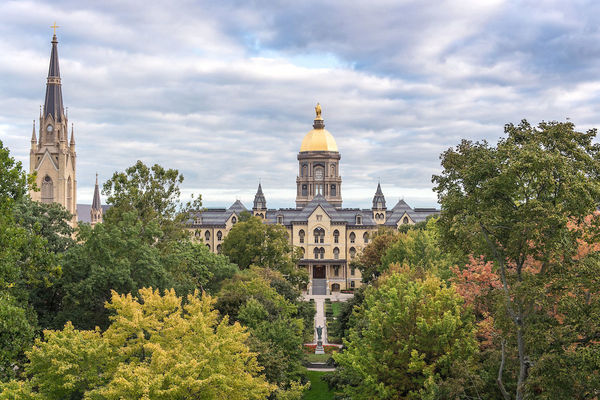
 Photo of the plaque at Tim and Lauren Carey’s tree and the message in the handmade album Lauren presented to Tim on their wedding day.
Photo of the plaque at Tim and Lauren Carey’s tree and the message in the handmade album Lauren presented to Tim on their wedding day.
When Lauren Carey planned her December 2015 wedding to her husband, Tim, she wanted to commemorate the occasion with something that would last through the years. Being quite the planner, Lauren began her search for a special gift about eight months before their big day.
Tim was a student in Mendoza’s Executive MBA program and would be graduating in May 2016. He would be the 25th person in his family to graduate from Notre Dame, and she knew the significant role the University has played in his family history and development.
When she heard about the University’s tree and bench program, something clicked. The idea was perfect.
“Myself being Jewish,” she says, “trees play a really important role in the Jewish religion as a symbol of life and fruitfulness, and the planting of a tree represents a high blessing for mankind and our relationship with and respect for the natural environment. Combine that with the tree being placed in the most meaningful place to my husband and his Irish Catholic heritage, I felt I had a winning idea. It wasn’t just for Tim, but for us as an interfaith, newlywed couple together.”
Every year, up to 10 memorial trees are planted on campus to celebrate an event in honor of a loved one.
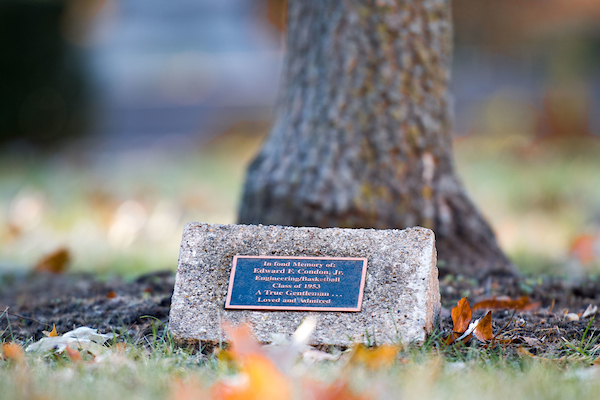 Campus tree donor plaque
Campus tree donor plaque
The wedding tree
Working with Teri Vitale, a lead coordinator in Special Events and Stewardship in the Office of Development, Lauren chose a young, small-leaved European linden tree near the Hesburgh Library reflecting pool, and tenderly wrote the following message to be engraved on the plaque: “To my loving husband Timothy J. Carey, Jr. on our wedding day, December 12, 2015. For every time you tell me you love me, know in your heart, mind and soul that I love you more. Let us be forever grateful for the infinite blessings we found in each other.”
On their wedding day in Delray Beach, Florida, Lauren gave Tim a handmade booklet with photos and captions, like this one, explaining her gift: “On our first trip to Notre Dame together, you walked me around the beautiful grounds telling me about the history of the school, your family, the people and so on. Your aura lights up when you speak of this incredible place.”
The gift meant more to Tim than any other, and when their family comes to campus it’s the first place they visit.
It is the story of just one tree cataloged among 7,156 trees at Notre Dame.
If that number seems strangely specific, you may not know that a plantings census was recently completed on over 97 percent of campus.
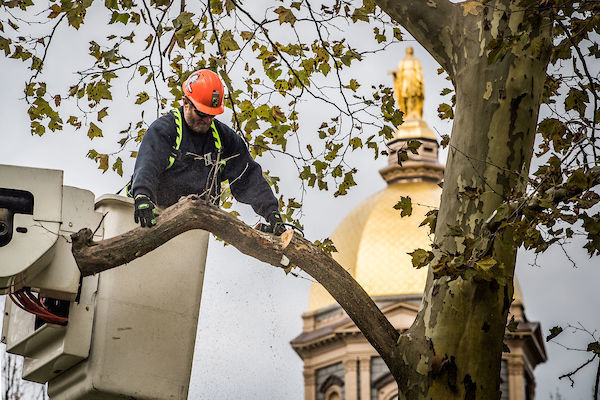 Landscape Services staff maintain a sycamore tree on main quad.
Landscape Services staff maintain a sycamore tree on main quad.
Trees are part of Notre Dame’s story
In November 1842, Rev. Edward Sorin, C.S.C., first laid eyes on the 524 acres bequeathed to the Congregation of Holy Cross to build a Catholic university. He must have appreciated the ash trees, oaks, hickories and maples that surrounded St. Mary’s and St. Joseph’s lakes. Sorin also knew what new trees could do for the landscape. The double-maple-lined paths leading from Notre Dame Avenue to the Main Building represent his idea of a lush, green “grand avenue” linking South Bend to campus.
All these years later, the ora on campus remains integral to its beauty — so much so that a couple of biologists were inspired to conduct a census
of plantings to commemorate the 175th anniversary of the University’s founding.
It would be the second time that Barbara and Ron Hellenthal, both faculty in the Department of Biological Sciences, would conduct such research. In 1993, to celebrate the University’s sesquicentennial, their work was published in the book “Trees, Shrubs and Vines on the University of Notre Dame Campus.” Ron managed the data and Barbara was a co-author.
About two years before the 175th anniversary, campus leaders caught wind of the Hellenthals’ project and considered how it could be expanded to also catalog the condition of each planting as well as the locations of donor memorial tree plaques, among other things.
A gift to Landscape Services from Tom and Lucy Korth for campus beautification got things started by covering the cost for the undergraduate researchers who worked with Barbara and Ron. The expanded project would make data work harder for the University and is a shining example of synergism between academic and administrative offices.
“Notre Dame is among the first universities to develop a project of this magnitude. It’s one of the most comprehensive surveys of trees and plants on any campus,” Ron proudly notes.
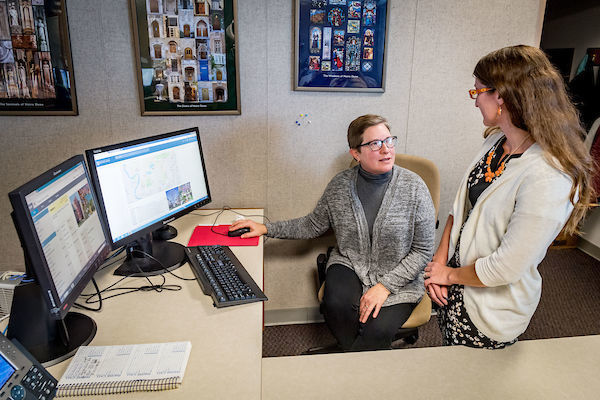 Jessica Woolley and Dana Schraeder
Jessica Woolley and Dana Schraeder
A tree census expands
Jessica Woolley, who managed the Work Control Center, where all campus maintenance requests are submitted, is among those who provided vision for the project. She saw the opportunity to utilize the data visualization and analysis tools of the University’s dataND program to make the tree survey information accessible to the campus community.
This would enable Landscape Services to electronically track and assess the condition of trees from one corner of campus to the other. Development would be able to pinpoint locations of benefactor trees and the corresponding memorial plaques. Facilities Design and Operations could use the visual tool to reference trees while managing the planning, design and construction of buildings. Meanwhile, the Office of Sustainability would use it to maintain a healthy green footprint on campus.
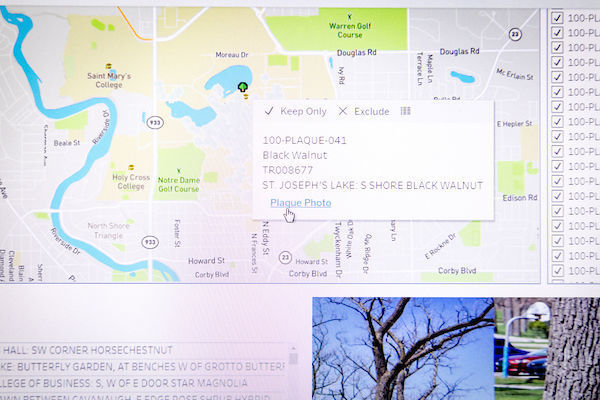
“Proper care of the University’s trees not only enhances the experience of students, alumni and visitors, but it also helps in our efforts to keep our campus green in every way,” says Carol Mullaney, senior director of the Office of Sustainability and Continuous Improvement.
The timing was perfect. The Office of Information Technologies (OIT) had begun to centralize data storage across campus through dataND to allow for better analysis of information for key decision-making. While dataND focuses on four core areas— faculty, staff, students and space (e.g., buildings, land) — the campus tree project aligned directly with the mission of dataND.
Dana Schrader, an OIT business intelligence analyst, partnered with Woolley on this part of the project.
 AiM System at the Work Control Center
AiM System at the Work Control Center
Putting that tree data to work
After the Hellenthals and the students recorded each tree, plant and vine, they entered all the information into a database. With the help of OIT’s Campus Admin Solutions, the Work Control Center then manipulated the data into the format and fields used in AiM, the University’s work-order system. Tableau software turned it into information that users across campus, with varying interests and needs, could retrieve.
Utilizing Tableau’s mapping capabilities and the GPS coordinates collected from the tree study, a campus map was created displaying the tree location and tree details such as its species, measurements and overall health. The next step was to transform the map into the interactive, informative dashboard that shows users the abundance of campus’ natural beauty in its trees and shrubs.
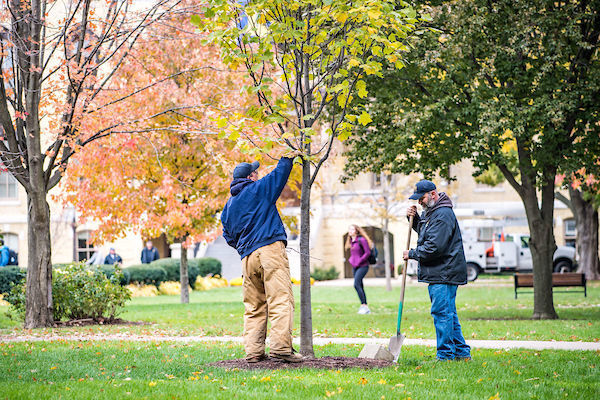 Landscape Services staff care for a tree on Main Quad
Landscape Services staff care for a tree on Main Quad
Pat McCauslin, superintendent of Landscape Services, values the tree inventory database. “It will aid our staff arborists and tree crews to protect and preserve the diversity of tree species on campus. Many of the trees were planted years ago by Holy Cross priests and brothers. Our team is dedicated to ensuring they remain healthy and vibrant for years to come.”
Campus trees are treasured in Notre Dame’s history, and even in the histories of Notre Dame families.
When Lauren thinks back about her gift of a tree, she says, “It remains the best gift I’ve ever given anyone, and quite frankly, I don’t have any intention of trying to top it. It holds such incredible and meaningful significance for each of us.”
To read more about this project, visit nd.edu/features/campus-trees.
Originally published by at evp.nd.edu on June 28, 2018.